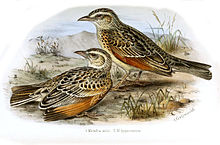Red-winged lark
| Red-winged lark | |
|---|---|

| |
| Scientific classification | |
| Domain: | Eukaryota |
| Kingdom: | Animalia |
| Phylum: | Chordata |
| Class: | Aves |
| Order: | Passeriformes |
| Family: | Alaudidae |
| Genus: | Corypha |
| Species: | C. hypermetra |
| Binomial name | |
| Corypha hypermetra (Reichenow, 1879) | |
| Subspecies | |
|
See text | |

| |
| resident range | |
| Synonyms | |
| |
The red-winged lark (Corypha hypermetra) is a species of lark in the family Alaudidae found in eastern Africa. It was formerly treated as conspecific with the Kidepo lark.
Taxonomy and systematics
The red-winged larkx was formerly placed in the genus Mirafra. It is one of several species that were moved to the resurrected genus Corypha based on the results of a large molecular genetic study by the Swedish ornithologist Per Alström and collaborators that was published in 2023.[2][3]
The red-winged lark is taken to form a species complex with the allopatric[4] rufous-naped lark, and perhaps with the Somali lark. The name "red-winged lark" is sometimes used as an alternate name for the Indian bush lark. The alternate names red-winged bush lark and rufous-winged bush lark may also be used to describe the Indian bush lark or the Bengal bush lark respectively.[5][6]
Subspecies
Two subspecies are recognized:[2]
- C. h. gallarum (Hartert, EJO, 1907) – Ethiopia
- C. h. hypermetra (Reichenow, 1879) – south Somalia to northeast Tanzania
This species and the Kidepo lark (Corypha kidepoensis) were formerly treated as conspecific. The Kidepo lark was elevated to species status based on results of a comprehensive integrated study of the genus Corypha that was published in 2024.[2][7]
Description

It is a larger version of the rufous-naped lark, with a more robust bill and longer tail,[8] but their morphological and vocal features do not intergrade where they occur together.[9]
Distribution and habitat
It has a patchy but quite extensive range in equatorial eastern Africa. It occurs within Ethiopia, Kenya, Somalia, South Sudan, Tanzania and Uganda, and its estimated global extent of occurrence is 660,000 km2.[1] Its total population has yet to be quantified, but is believed to be large.[1]
Its natural habitat is savanna[8] in tropical to subtropical dry, open, lowland.
References
- ^ a b c BirdLife International (2016). "Mirafra hypermetra". IUCN Red List of Threatened Species. 2016: e.T22717038A94518943. doi:10.2305/IUCN.UK.2016-3.RLTS.T22717038A94518943.en. Retrieved 11 November 2021.
- ^ a b c Gill, Frank; Donsker, David; Rasmussen, Pamela, eds. (August 2024). "Nicators, Bearded Reedling, larks". IOC World Bird List Version 14.2. International Ornithologists' Union. Retrieved 12 September 2024.
- ^ Alström, P.; Mohammadi, Z.; Enbody, E.D.; Irestedt, M.; Engelbrecht, D.; Crochet, P.-A.; Guillaumet, A.; Rancilhac, L.; Tieleman, B.I.; Olsson, U.; Donald, P.F.; Stervander, M. (2023). "Systematics of the avian family Alaudidae using multilocus and genomic data" (PDF). Avian Research. 14: 100095. doi:10.1016/j.avrs.2023.100095.
- ^ Britton, P. L., ed. (1980). Birds of East Africa: 612. Mirafra africana Smith Rufous-naped Lark KTU 659. Nairobi: EANHS. p. 114.
- ^ "Mirafra erythroptera – Avibase". avibase.bsc-eoc.org. Retrieved 2016-11-28.
- ^ "Mirafra assamica – Avibase". avibase.bsc-eoc.org. Retrieved 2016-11-28.
- ^ Alström, P.; Mohammadi, Z.; Donald, P.F.; Nymark, M.; Enbody, E.D.; Irestedt, M.; Elisha, E.B.; Ndithia, H.K.; Tieleman, B.I.; Engelbrecht, D.; Olsson, U.; Rancilhac, L.; Stervander, M. (2024). "Integrative taxonomy reveals unrecognised species diversity in African Corypha larks (Aves: Alaudidae)" (PDF). Zoological Journal of the Linnean Society. 200 (4): 1080–1108. doi:10.1093/zoolinnean/zlad107.
- ^ a b Sinclair, Ian; Ryan, Peter (2010). Birds of Africa south of the Sahara (2nd ed.). Cape Town: Struik Nature. p. 330. ISBN 9781770076235.
- ^ "Rufous-naped Lark (Mirafra africana) - HBW 9, p. 551". Internet Bird Collection. Lynx Edicions. Retrieved 29 June 2016.
- Compilers: Stuart Butchart, Jonathan Ekstrom (2008). "Red-winged Lark – BirdLife Species Factsheet". Evaluators: Jeremy Bird, Stuart Butchart. BirdLife International. Retrieved May 10, 2009.

